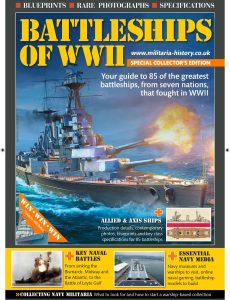
Battleships of WWII – February 2023
English | 134 pages | pdf | 118.61 MB
Welcome at Battleships of WWII Magazine February 2023 Issue
While the battles on the ground in WWU have rightly been recognised as key events in the war, those fought at sea had an equally important role. Sea was the route by which American materiel kept Britain and the Soviet Union fighting in the darkest days of WWH. Without those supplies the war effort would have run duty, the population out of food and the efforts of those on the ground and in the air would have been in vain. There were four key areas – the Atlantic crossing to Britain; the Arctic run to supply the Soviet Union; the Mediterranean where British, Italian and German forces fought it out; and the Pacific, where the Allies took on the naval might of Imperial Japan. In this special, 132-page collector’s edit-ion bookazine, we take a look at the key naval battles and the ships that fought them.
While sea battles typically involved destroyers., cruisers, and in the Pacific especiaUy, aircrat carriers, here we are f looking at the role and specification of
the battleships, the mightiest ships of all. At the start of \VWU, the most powerful navies arguably belonged to Britain and Japan, but it didn”t take the USA long to outbuild both, thanks to its vastly superior industrial capacity. Meanwhile, the German ships were a danger in the Atlantic and North Sea to both shipping and Britain’s warships, which made it a priority of the Admiralty to send as many to seabed as fast as possible.
Here you will find 85 battleships and pocket battleships, with schematics for each class, a build history and their role in WWll They are organised by country and then by class, such as the Queen Elizabeth class, where the ships had similar characteristics. There are specification panels for aU classes and the ships where they differed from each other.
At the start of each section we take a look at the strategic situation for each of the navies represented here: Great Britain, France, USA, Soviet Union, Germany, Italy and Japan. Various treaties in the 1920s and ’30s had restricted what could be built and so, on the eve of WWU, some navies were still equipped with WWI-era dreadnoughts. These were hastily upgraded as the main threat soon became apparent – that of attack from the air. After the early war clashes between ships, it was the aircraft carrier war in the Pacfic that i
became the focus point, and finally., towards the end, the battleships were lending their awesome weaporny to support landings in France, Italy and the Pacific islands.
To conclude this special collector’s guide to the battleships of WWII, we take a look at naval museums and floating warships around the world for you to visit; battleship models you can build; online naval simulations to play; and finally, how to take your interest to the next level by collecting naval militaria.
Duncan Evans, Editor
Download from: